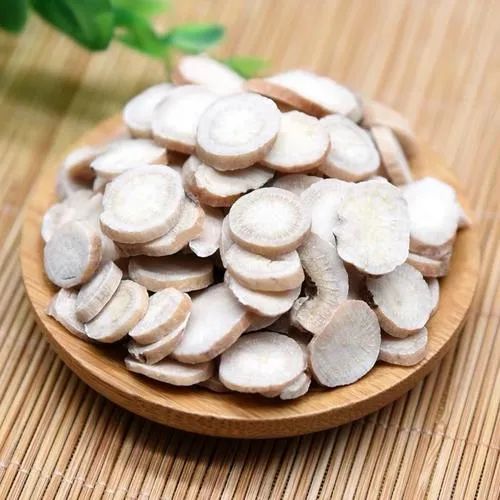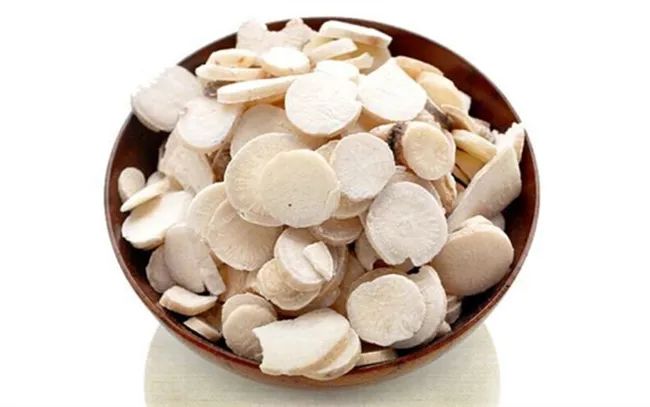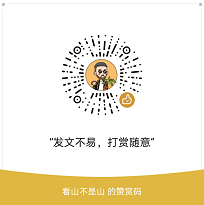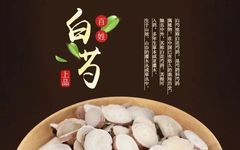
Bai Shao (白芍) is a commonly used herb in Traditional Chinese Medicine (TCM). In ancient times, it was often gifted between men and women to express affection or parting sentiments, hence it is also known as “Jiang Li Cao” (将离草). The root can be used medicinally, with distinctions between Chi Shao (赤芍) and Bai Shao. Bai Shao, also known as Bai Shao Yao, is described in the text “Yao Pin Hua Yi” as having the ability to both tonify and purge, specifically acting on the blood sea. It is particularly beneficial for women in regulating menstruation and childbirth, and for men with liver diseases, making it suitable for harmonizing blood and qi. Let’s explore the efficacy and uses of Bai Shao, as well as its dietary precautions.

01
The Efficacy and Uses of Bai Shao
1. Nourishing Blood and Regulating Menstruation. This is the most prominent effect of Bai Shao. Its sour taste enters the liver, helping to tonify qi and nourish blood, making it very suitable for women. Bai Shao is often used to assist with conditions such as yin blood deficiency, blood deficiency dizziness, pale complexion, and irregular menstruation. When combined with Dang Gui (当归), E Jiao (阿胶), and Chuan Xiong (川芎), its effects in nourishing blood and regulating menstruation are enhanced.
2. Softening the Liver and Alleviating Pain, Calming Liver Yang. Bai Shao can soften and nourish the liver, providing excellent regulation for those with liver issues and helping to repair certain liver damage. It alleviates symptoms such as rib pain and dizziness caused by disharmony of liver qi and excessive liver yang. Additionally, Bai Shao has notable analgesic effects, assisting with acute abdominal pain and limb spasms, often used in conjunction with Gan Cao (甘草), Bai Zhu (白术), and Fang Feng (防风).
3. Astringing Yin and Stopping Sweating. The acidic substances in Bai Shao have astringent properties, which can help stop sweating. Patients with deficiency often experience spontaneous sweating or night sweats, and Bai Shao can alleviate these issues to some extent. It also has good auxiliary effects for symptoms of sweating due to external wind-cold. When combined with Gui Zhi (桂枝), Long Gu (龙骨), and Fu Xiao Mai (浮小麦), its astringent and sweat-stopping effects are enhanced.
4. Beauty and Skin Care. Bai Shao is traditionally known for its skin-nourishing and whitening properties. In ancient times, it was widely used in formulas like San Bai Tang (三白汤) made with Bai Zhu and Bai Fu Ling (白茯苓), which have excellent effects in whitening and nourishing the skin, as well as tonifying qi and blood. From a TCM perspective, it achieves skin brightening and beautification by regulating organ functions and ensuring smooth circulation of qi and blood. Furthermore, Bai Shao’s blood-nourishing and activating properties help women appear more radiant, effectively addressing issues like rough, sallow skin, lack of luster, and pigmentation.

02
Dietary Precautions for Bai Shao
Usage Guidelines
Those with blood deficiency or yin deficiency are suitable for consumption. However, individuals with yang deficiency and cold should not take it alone. Those with cold abdominal pain or diarrhea should avoid Bai Shao. Bai Shao is also incompatible with Li Lu (藜芦) and should not be used together.
Properties and Channels
It is slightly cold in nature, with a bitter and sour taste, entering the liver and spleen channels.
How to Select
Choose roots that are thick, long, straight, with a smooth skin, firm texture, and a white, powdery cross-section without white hearts or cracks. Bai Shao can be processed in different ways, including Chao Bai Shao (炒白芍), Jiu Bai Shao (酒白芍), and Tu Chao Bai Shao (土炒白芍).
Raw Consumption
In moderation, Bai Shao can be washed and eaten raw, which has the effect of nourishing yin and stopping sweating.
Tea Substitute
Combine 10 grams each of Bai Shao and Fu Ling (茯苓), 6 grams of Ling Zhi (灵芝), 15 grams of Suan Zao Ren (酸枣仁), 9 grams of Yuan Zhi (远志), and an appropriate amount of honey. Boil all the herbs in water, strain the liquid, and mix in honey before drinking. Take one dose daily for seven days; this tea has the effect of nourishing heart blood and calming the spirit.
Decoction
For chronic hepatitis (liver and kidney yin deficiency type): use 10 grams each of Bai Shao and Jin Yin Hua (金银花), and 5 grams each of Chai Hu (柴胡) and Gan Cao. Decoction for drinking.
For constipation (blood deficiency type): use 20-50 grams of Bai Shao and 10 grams of Gan Cao. Decoction for drinking.
For rheumatoid arthritis: use 30 grams of Bai Shao, and 10 grams each of Wu Jia Pi (五加皮) and Gan Cao. Decoction for drinking.

【Disclaimer】: This article is sourced from the internet, and copyright belongs to the original author. Please indicate the source when reprinting. Sharing this article is for the purpose of dissemination and learning exchange, and does not hold responsibility for the views expressed. The various dietary therapy methods, medicinal formulas, and prescriptions mentioned are for reference and learning only; non-professionals should not use them blindly! The advertisements in the article are automatically generated by the system and are unrelated to this account. If you have any questions, please leave a message online, and we will handle it as soon as possible. Thank you.


Click “Read the Original“↙ to see more exciting content


